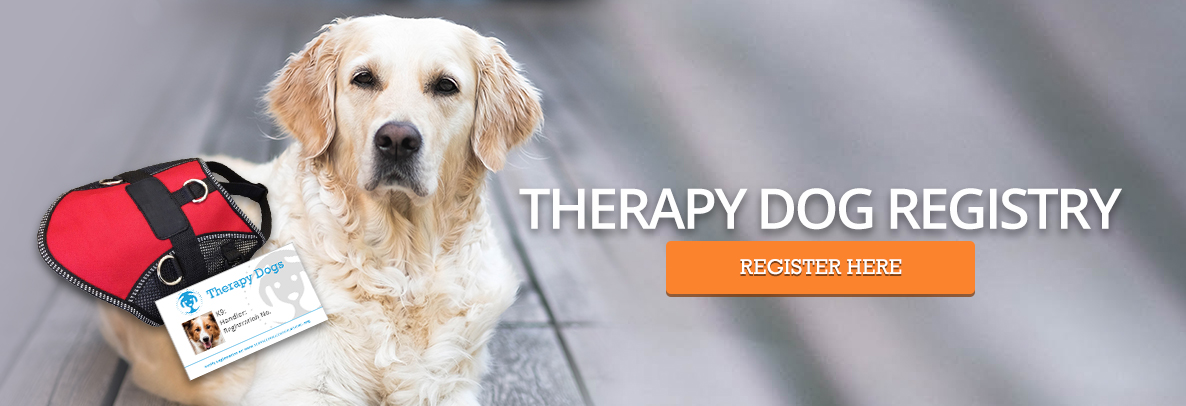How to Certify a Therapy Dog

Getting your dog certified as a therapy dog can give it more credibility and open doors to places that need them, like hospitals, schools, and nursing homes. The certification process can take 3–6 months and costs between $300 and $500, depending on the organization you choose.
Getting your dog certified as a therapy dog takes these three steps:
- Train until you’re both ready
Your dog needs to know basic commands, as well as the ability to ignore dropped pills, beeping machines, and grabby hands. - Pick an organization that makes sense
Choose a therapy dog group based on where you live and what you want to do. - Pass the certification test together
You both will be evaluated on whether you can handle real therapy situations safely and effectively.
There’s no official government therapy dog certification. Instead, private nonprofit organizations test and certify therapy dog teams. Certification can provide liability insurance, credibility, and access to facilities that require proof that your dog has been properly evaluated for working with vulnerable populations.
This article will explain everything you need to know about certifying a therapy dog. Check out our guide on how to get a therapy dog if you want to learn about everything from selecting a dog, training, and getting invited to facilities.
In this article:
- Step 1: Getting your dog ready
- Step 2: Choosing your certification group
- Step 3: The evaluation (your dog’s job interview)
- Certification process questions
Step 1: Getting Your Dog Ready
Most dogs sit nicely for treats at home, but therapy work is a different matter. During a nursing home visit, someone drops their medication on the floor, the dog goes for it, and suddenly, there’s an explanation needed about why the therapy dog just ate someone’s heart pills.
Every therapy dog needs rock-solid basics before pursuing certification:
- Sit, down, stay for at least 30 seconds (consistently, not just when convenient)
- Come when called, even when distracted
- Walk on a loose leash without pulling
- Leave dropped food alone, no matter how tempting
The real challenges come from unpredictable environments, like hospitals and schools. Wheelchairs that squeak. Machines that beep randomly. Kids who pet with sticky hands or grab ears. Dogs need to handle all of it without getting stressed or excited.
Many teams fail their first evaluation because dogs that are perfect at home completely lose focus when evaluators bring out walkers or other medical equipment. Consistent practice over several weeks can resolve this issue.
Training Progression Chart
| Phase | Skills to Master | Practice Time | Key Focus |
|---|---|---|---|
| Foundation | Sit, down, stay (30+ sec), come, heel, leave it | 2–4 weeks | Basic control in quiet settings |
| Public Manners | Accept strangers, walk through crowds, ignore other dogs, remain calm during distractions | 4–6 weeks | Safe behavior around people |
| Therapy-Specific | Handle medical equipment, awkward petting, emotional situations | 6–8 weeks | Real facility scenarios |
| Advanced | Multiple people petting, loud noises, extended down-stays | 2–4 weeks | Actual visit conditions |
Step 2: Choosing Your Certification Group
You technically could visit facilities without certification, but good luck getting past the front desk. Legitimate facilities require therapy dogs to be certified through recognized groups because these organizations provide:
- Liability insurance ($1–2 million coverage) protects you if someone trips over your dog
- Standardized training so facilities know what to expect
- Credibility that opens doors at hospitals, schools, and nursing homes
- Support when you encounter challenging situations
Here are a few notable therapy dog groups:
Pet Partners requires completion of a handler course (online $80 or in-person), team evaluation, health screening by a veterinarian, and background check. They certify nine different species, including cats, rabbits, and llamas.
Therapy Dogs International (TDI) dogs must be a minimum of one year old and pass a temperament evaluation conducted by a certified TDI evaluator, with testing costing $25 plus membership fees.
Alliance of Therapy Dogs uses a unique hands-on testing process. Dogs must pass an evaluation where evaluators physically handle the dog, followed by three supervised visits, including two at medical facilities, with an annual membership fee of $35 plus a $20 initial fee.
Love on a Leash emphasizes extensive mentorship. Dogs must pass control evaluation administered by certified professionals, followed by at least five supervised visits with the same certified member, with dogs requiring a minimum of one year of age.
Bright & Beautiful Therapy Dogs offers flexibility for remote areas. Dogs must pass their therapy dog test, with long-distance certification available for those more than two hours from evaluators.
Therapy Dogs United maintains strict standards. Dogs must pass the TDU therapy dog evaluation, with handlers undergoing background checks and committing to a minimum of six visits annually.
Organization Comparison Chart
| Organization | Cost | Certification Requirements |
|---|---|---|
| Pet Partners | $80 course + evaluation fees | Handler course + team evaluation + health screening + background check |
| TDI | $25 test + membership | Temperament evaluation only, dog 1+ years old, current vaccinations |
| Alliance of Therapy Dogs | $35/year + $20 initial | Hands-on evaluation + 3 supervised visits (2 medical facilities) |
| Love on a Leash | Varies by region | Control evaluation by certified professional + 5 supervised visits with same mentor |
| Bright & Beautiful | $50 + membership | Pass B&B therapy dog test + health certificate (CGC not required) |
| Therapy Dogs United | CGC + TDU test fees | Must pass CGC first + TDU evaluation + background checks |
To help you choose which organization to go with, call the facilities where you’d like to volunteer. Ask which organizations they work with. Some facilities have exclusive contracts with specific organizations. There’s no point in getting certified through TDI if your local hospital only accepts Pet Partners teams.
Step 3: The Evaluation (Your Dog’s Job Interview)
The evaluation begins the moment you arrive. Evaluators observe how dogs exit cars, walk across parking lots, and enter buildings. It’s essentially a job interview where both handler and dog are being assessed.
Each organization tests differently, but all aim to answer the same question: Can this team handle real therapy situations without creating problems?
Pet Partners might use volunteers pretending to be patients — someone “crying” to test the dog’s reaction to emotional distress, or using mobility equipment awkwardly to assess responses to unexpected movements.
TDI focuses on temperament testing with wheelchairs, dropped objects, and various distractions designed to simulate the chaos of a healthcare facility.
Alliance evaluators handle dogs themselves, checking whether they genuinely enjoy interaction or merely tolerate it.
Common Evaluation Scenarios
| Test Scenario | What It Measures | Preparation Tips |
|---|---|---|
| Wheelchair/Walker Approach | Comfort with mobility devices | Practice at medical supply stores |
| Sudden Loud Noises | Startle recovery | Drop pans at home (start softly) |
| Awkward Petting | Tolerance for rough handling | Have friends practice clumsy touches |
| Leave It Command | Impulse control with temptations | Use high-value treats and medication props |
| Supervised Separation | Independence from handler | Practice brief separations in public |
| Crowd Navigation | Calm behavior in busy areas | Visit shopping centers, farmers markets |
| Medical Equipment | Comfort around beeping devices | Borrow equipment or visit hospitals |
Certification Process Questions
What documents do I need for certification?
All organizations require current vaccination records and veterinary health clearance. Some organizations require background checks. Certain organizations require evaluations to be administered by certified professionals such as animal behaviorists, dog trainers, or obedience instructors.
What happens if my dog fails the evaluation?
Retesting policies vary significantly between organizations. Some charge the full evaluation fee again with no refunds, while others may offer free or discounted retesting. Contact your chosen organization directly for their specific retesting policy and any waiting periods.
Can I get certified through multiple organizations?
Some organizations explicitly prohibit dual membership and will not register dogs already certified elsewhere. Other organizations allow multiple certifications. Check individual organization policies before pursuing multiple certifications.
What are the basic costs involved?
Testing fees range from $25 to over $100, depending on the organization. Handler education courses, where required, typically cost $50–$100. Annual membership fees range from $35 to $100. Additional costs may include training, equipment, and background checks.
Is liability insurance included?
Many major organizations provide liability insurance coverage as part of membership, typically ranging from $1–2 million in coverage. This insurance generally covers only official visits conducted through the organization, not personal use of your dog.
How long do certifications last?
Most organizations require annual renewal, though some offer two-year registration periods. Renewal typically requires updated health records, membership fees, and sometimes re-evaluation or continuing education.
Do I need professional training before testing?
Requirements vary by organization. Some require completion of specific handler education courses, while others focus solely on the dog’s performance during evaluation. Basic obedience skills are essential for all evaluations, regardless of formal training requirements.

About the Author: The writing team at Service Dog Certifications is made up of folks who really know their stuff when it comes to disability laws and assistance animals. Many of our writers and editors have service dogs themselves and share insights from their own experiences. All of us have a passion for disability rights and animals.
Latest Posts

Dangerous Materials Hiding in Your Dog Products
Jake’s German Shepherd began developing strange rashes around his collar. Three vet visits later, they figured out the leather was treated with chromium — a chemical that irritates sensitive skin. Jake had no idea his dog’s collar contained industrial chemicals. Most dog owners don’t know what goes into the products they buy. Many companies use […]

Read More

Can You Bring a Service Dog to a Basketball Game?
Yes, you absolutely can bring your service dog to basketball games. Whether you’re heading to your local high school tournament, a packed college rivalry game, or splurging on NBA tickets, the Americans with Disabilities Act protects your right to be accompanied by your service dog anywhere the public can go. When you arrive, venue employees […]

Read More

Best Pet Health Insurance Providers
If you own a pet, you know how important — and expensive — vet care can be. One way to offset those costs is to purchase pet health insurance. Like typical health insurance, pet insurance is available at many price points, and can cover all, most, or only some of your vet-related costs. It can […]

Read More